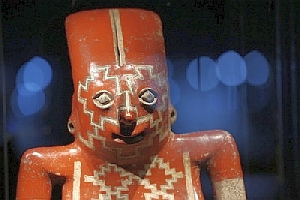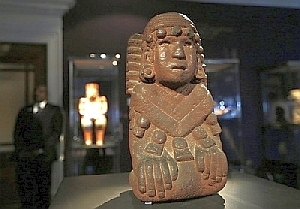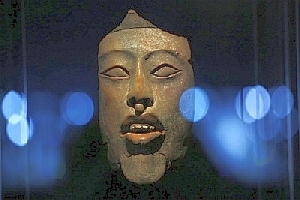Mexico City, Mexico — The Mexican government is demanding that Sotheby’s auction house halt the planned sale of 51 pre-Columbian Mexican artifacts, arguing they are protected national historical pieces.
The National Institute of Anthropology and History said Wednesday that Mexico has sent a diplomatic note to the French government seeking assistance in heading off the auction scheduled in Paris for Friday and Saturday.
It also implied that some of the artifacts offered in what is known as the 300-piece Barbier-Mueller Collection of Pre-Columbian Art are fakes or imitations.
"Of the 130 objects advertised as being from Mexico, 51 are archaeological artifacts that are Mexican national property, and the rest are handicrafts," the institute said in a statement. Still, the genuine pieces are important to Mexico.
"In light of their importance for the people of Mexico, the director of the auction company has been asked to withdraw the pieces from sale," the institute said.
Sotheby’s issued a statement Thursday saying it "has had dialogue with several nations and given careful consideration to their concerns about this sale, and we continue to welcome discussion regarding any new information on specific issues."
 |
The auction house said that over six months, it "thoroughly researched the provenance of this collection and we are confident in offering these works for auction." Sophie Dufresne, Sotheby’s spokeswoman in Paris, said: "The sale is going forward as planned."
A description of the pieces listed on Sotheby’s Paris website describes the collection as containing pre-Hispanic sculptures in wood and stone, ceramics, textiles, and ritual objects from Mexico, Central America, and South America, saying the collection is "representative of all the leading pre-Columbian cultures."
The Sotheby’s website says the collection was started by Josef Mueller in 1920. "He became attracted by important works of pre-Columbian art, his first purchase being an Aztec ‘water goddess’ in Paris in 1920," it says.
The description says Mueller’s son-in-law, Jean Paul Barbier-Mueller, augmented and broadened the collection.
While Sotheby’s described Barbier-Mueller as "a great aesthete and man of culture," Mexico said such collections trivialize archaeological pieces.
 |
"The Mexican government has consistently expressed its objections to the international trade in protected cultural objects, particularly archaeological artifacts, and stresses that such practices strip these unique objects of their invaluable cultural, historical, and symbolic essence, converting them into mere merchandise and curios," the institute said.
Under a 1972 law, Mexico prohibited the purchase and sale of archaeological pieces, but allowed some previously existing collections to remain in private hands if they were registered with the government.
While the French collection may have been assembled prior to that time, Mexico has had laws prohibiting the export of such artifacts since at least 1827.
Photos of the artifacts on the Sotheby’s site show two seated depictions of godlike figures carved in stone that appear to come from Mexican pre-Hispanic cultures. The description says the collection contains Aztec, Mayan, and Tarascan pieces.
A French diplomatic official said that nothing in the collection up for auction is on the French database checked by the Central Office of Cultural Property. Nor are any of the items in the Interpol database or on the "red list" of the International Council of Museums for cultural property of Central America and Mexico.
The diplomatic official, who was not authorized to speak publicly and asked not to be named, said these objects have often been shown publicly and mentioned in various catalogues since September.


